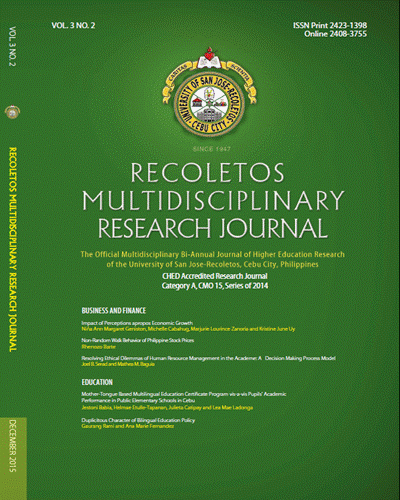Non-Random Walk Behavior of Philippine Stock Prices
DOI:
https://doi.org/10.32871/rmrj1503.02.02Keywords:
Random walk, unit root, autocorrelations, sequences, reversals, runsAbstract
Random walk has been held as a sufficient condition for describing the stock market as efficient, which implies that investors cannot predict the market returns or equivalently, abnormal profits cannot be obtained just by knowing the past prices. This study tests the random walk hypothesis in the case of Philippine Stock Prices, using the daily PSE index (PSEi) covering the period 03 January 2005-16 February 2016. Main results, employing the informal or visual methods such as plot analysis of log returns and correlogram, suggest some initial evidence of non-randomness. The formal methods, employing tests for unit root, runs, sequences and reversals, variance ratio, and autocorrelations, show that the PSEi prices do not follow a random walk behavior.
References
Alexeeva, V. and Maynard, A. (2012). Localized level crossing random walk test robust to the presence of structural breaks. Computational Statistics and Data Analysis, 56: pp.3322-3344
Abosede, A. and Oseni, J. (2011). Theoretical Analysis of Firm and Market-Specific Proxies of Information Asymmetry on Equity Prices in the Stock Markets, Australian Journal of Business and Management Research, Vol.1 No.2: pp.1-13
Al-Khazali, O., Pyun, C. and Kim, D. (2011). Are exchange rate movements predictable in Asia-Pacific markets? Evidence of random walk and martingale difference processes. International Review of Economics and Finance, 21:pp. 221–23
Ang, J. and Pohlman, R. (1978). A Note on the Price Behavior of Far Eastern Stocks. Journal of International Business Studies, Vol. 9, No. 1: pp.103-107
Chaudhuri, K. and Wu, Y. (2003). Random Walk Versus Breaking Trends in Stock Prices: Evidence from Emerging Markets, Journal of Banking and Finance, V.27: pp.575-592
Chen,J. and Diaz, J. (2014). Predictability and Efficiency of the Philippine Stock Exchange Index. Journal of Business and Economics, Volume 5, No. 4, pp. 535-539.DOI: 10.15341/jbe(2155-7950)/04.05.2014/009
Dutta, S., Essaddam, N., Kumar, V. and Saadi, S. (2015). How does electronic trading affect efficiency of stock market and conditional volatility? Evidence from Toronto Stock Exchange. Res. Int. Business Finance, http://dx.doi.org/10.1016/j.ribaf.2015.11.001
Fama, E. (1965). The Behavior of Stock-Market Prices The Journal of Business, Vol. 38, No. 1: pp. 34-105.
Fama, E. (1965). Random Walks in Stock Market Prices. Financial Financial Analysts Journal, pp.55-59
Janairo, C. and Roleda, R .(2012). The characterization of Philippines stock Market index. The Manila Journal of Science , 7, 2:pp 1-9
Harper ,A. and Jin, Z. (2012). Examining market efficiency in India: An empirical Analysis of Random Wal Theory, Journal of Finance and Accountancy, Vol 10. Retrieved from http://www.aabri.com/manuscripts/121128.pdf
Harper, A. and Jin, Z. and Sokunle, R. (2015). Examining market efficiency: A view from the silver futures market. Journal of Finance and Accountancy. Volume 20. Retrieved from http://www.aabri.com/manuscripts/121128.pdf
Karemera, D., Ojah, K. and Cole, J. (1999). Random Walks and Market Efficiency Tests: Evidence from Emerging Equity Markets, Review of Quantitative Finance and Accounting, 13: pp. 171-188
Kawakatsu, H. and Morey,M. (1999). An Empirical Examination Of Financial Liberalizationand: The Efficiency Of Emerging Market Stock Prices, The Journal of Financial Research Vol. XXII, No. 4: pp. 385-411
Khan, W. and Vieito, J. (2012). Stock exchange mergers and weak form of market efficiency: The case of Euronext Lisbon. International Review of Economics and Finance, 22: pp. 173–189
Kilon, J. and Jamroz, P. (2015). Informational (in)efficiency of the Polish Stock Exchange. Procedia - Social and Behavioral Sciences, 213:pp.390 – 396
Kim, J. and Shamsuddin, A. (2008). Are Asian stock markets efficient? Evidence from new multiple variance ratio tests, Journal of Empirical Finance, 15: pp. 518–532
Kim, E. H. and Singal, V. (2000). Stock Market Openings: Experience of Emerging Economies. Journal of Business, Vol. 73, no. 1: pp.25-66
Lean, H. and Smyth, R. (2007). Do Asian Stock Markets Follow a Random Walk? Evidence from LM Unit Root Tests with One and Two Structural Breaks. Review of Pacific Basin Financial Markets and Policies, Vol. 10, No. 1: pp. 15–31
Livingston, M. (1977). Industry Movements of Common Stocks, The Journal of Finance, Vol. 32, No. 3: pp. 861-874
Lo, A. and MacKinlay, A. (1988). Stock Market Prices do not Follow Random Walks: Evidence from a Simple Specification Test. The Review of Financial Studies, Vol. 1, No. 1: pp. 41-66
Okpara, G. (2010). Stock market prices and the random Further evidence from Nigeria Journal of Economics and International Finance, Vol. 2(3): pp. 049-057
Oskooe, S., Li, H. and Shamsavari, A. (2010). The Random Walk Hypothesis in Emerging Stock Market. International Research. Journal of Finance and Economics, Issue 50: pp.51-61
Reilly. F. (1971). Price Changes in Nyse, Amex and Otc Stocks Compared. Financial Analysts Journal, Vol. 27, No. 2: pp. 54-59
Tiwari, A. and Kyophilavong, P. (2014). New Evidence from the random walk hypothesis for BRICS stock indices: a wavelet unit root test approach. Economic Modelling, Vol 43: pp. 38-41
Solnik, B. H. (1973). Note on the Validity of the Random Walk for European Stock Prices. Journal of Finance, pp. 1151-1159.
Yang, A. and Pangastuti, A. (2016). Stock Market Efficiency and Liquidity: The Indonesia Stock Exchange Merger. Research in International Business and Finance, vol 36: pp. 28-40
Zahedi, J. and Rounaghi, M. (2015). Application of artificial neural network models and principal component analysis method in predicting stock prices on Tehran Stock Exchange. Physica A 438: pp. 178–187
Books
Campbell, J., Lo, A., and MacKinlay, A. (1997). The Econometrics of Financial Markets, Princeton university Press: New Jersey, USA.
Copeland, T., Weston, J., and Shastri, K. (2005). Financial Theory and Corporate Policy 4th Ed., Person Education, Inc., USA
Danao, R. (2010). Introduction to Statistics and Econometrics, UP Press, Quezon City, Philippines.
Gujarati, D. (2004). Basic Econometrics, 4th edition, McGrawhills, Co., USA
Websites
http://www.pse.com.ph/stockMarket/circulars.html
http://www.pse.com.ph/resource/filetemplate/file/pseindexguide.pdf
http://www.pse.com.ph/corporate/home.html
http://pse.com.ph/stockMarket/marketInfo-marketActivity.html?tab=1&indexName=All%20Shares
Downloads
Published
How to Cite
Issue
Section
License
Copyright of the Journal belongs to the University of San Jose-Recoletos


